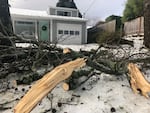
Tree damage in Southeast Portland on Monday.
Michael Bendixen / OPB
This month’s snow and ice storms in western Oregon knocked out power for more than half a million utility customers and littered streets and sidewalks with branches. Now a lot of trees are needing some TLC to help them recover.
Ian Bonham is a neighborhood trees senior specialist with Friends of Trees in Portland, a nonprofit dedicated to planting and maintaining trees and native plants throughout the region. He says in most cities it’s the homeowner’s responsibility to take care of trees on their property and adjacent to their homes. Still, you’ll want to check in with your city’s urban forestry department before making any changes.
“Mostly that’s just to make sure I’m taking care of the tree in the right way and make sure I’m not doing any further damage to the tree,” Bonham said.
Also, get ready to be patient: most cities are struggling to keep up with incoming requests for help. Portland Parks & Recreation’s urban forestry specialists say it could take days to respond for information requests and weeks for them to pick up all the piles of debris scattered across the city. (If you’re in Portland, you can find more information here.)
Bonham warns against being too cavalier with DIY tree pruning, though; there are a lot of ways things can go wrong. Trying to prune branches that are heavy or require you to get on a ladder create a risk that you could injure yourself, hurt the tree or damage a nearby structure; you won’t be very popular in your neighborhood if your tree pruning efforts knock out power.
Instead, Bonham strongly recommends reaching out to a professional arborist with the skills and equipment to prune most trees in a way that will help the tree heal itself quickly and prevent decay and future damage.
But if you have a low-hanging branch that isn’t too heavy, and you’re eager to repair it yourself, make sure you read up on proper pruning techniques before you start cutting. Bonham says that following your intuition could lead you to cause more harm than good.
“For example, a lot of people will look at their tree after an ice or windstorm and say ‘Oh, I have to hack off all the branches,’” he said. “That’s called ‘topping’ the tree and could create a hazardous tree out of what was a healthy tree.”
The undeterred DIY’er can read up on proper pruning techniques here.
The best thing you can do for the health of your trees is to think proactively. Scheduling a routine maintenance check-up on your trees with a specialist every couple of years will make them healthier and more resilient when the next ice storm hits.
“Have them see if there are any damaged branches or dead branches hanging in the tree,” Bonham said. “They’ll also be able to provide structural pruning so that your tree can go safely. An arborist knows how different species are going to grow so they can make preventive cuts to avoid future damage.”
If the worst case has happened, and your tree is beyond repair, it’s time to think about a replacement. You can reach out to Friends of Trees for guidance on what tree to consider replanting in your space. Bonham says slower-growing trees are stronger and more resilient during icy conditions. You can check your availability to get a tree from Friends of Trees here.
